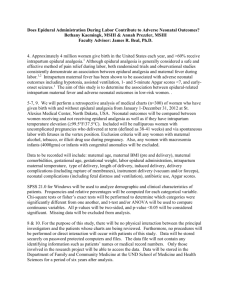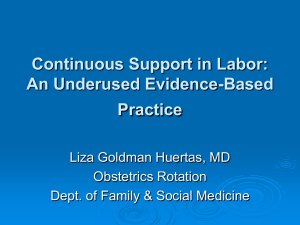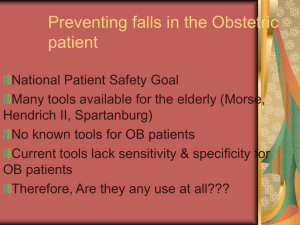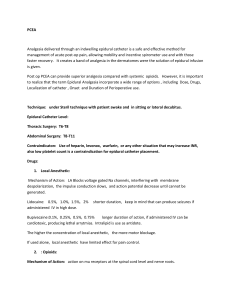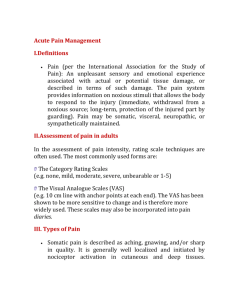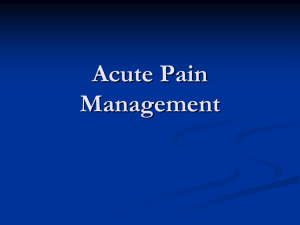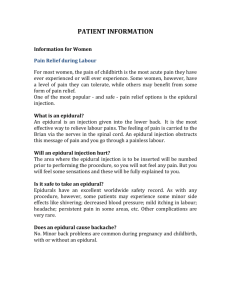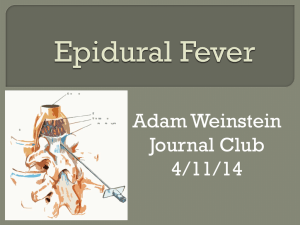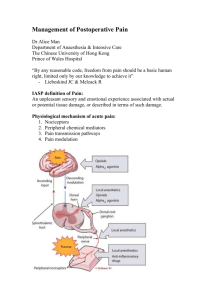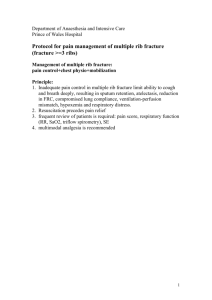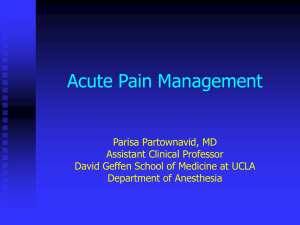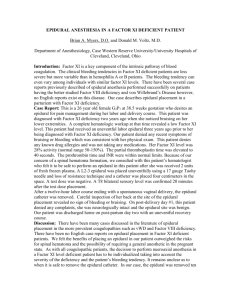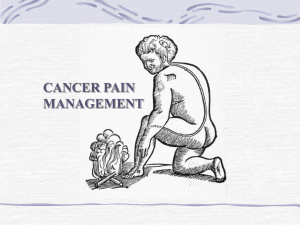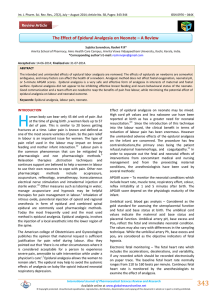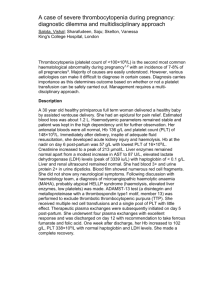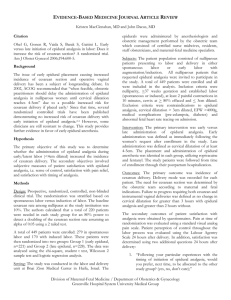Management of Labor Pain
advertisement
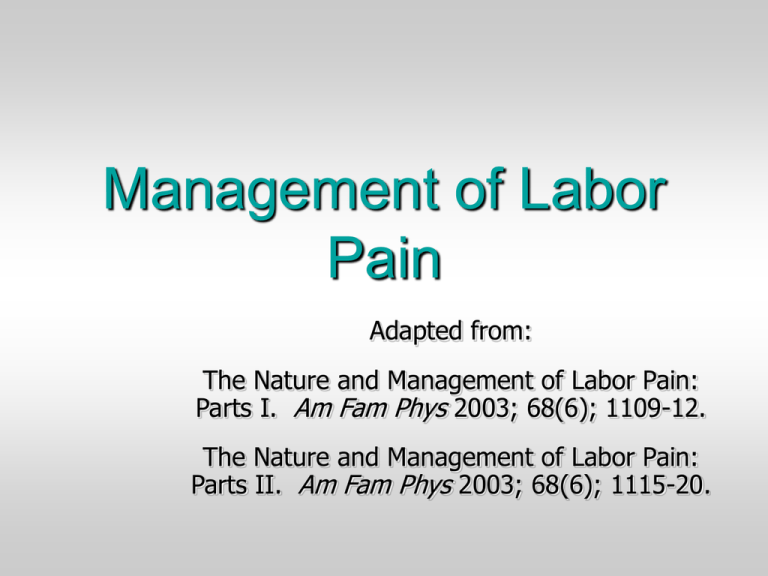
Management of Labor Pain Adapted from: The Nature and Management of Labor Pain: Parts I. Am Fam Phys 2003; 68(6); 1109-12. The Nature and Management of Labor Pain: Parts II. Am Fam Phys 2003; 68(6); 1115-20. The Debate… “Labor results in severe pain for many women. There is no other circumstance where it is considered acceptable for a person to experience untreated severe pain, amenable to safe intervention, while under a physician’s care… Maternal request is a sufficient medical indication for pain relief during labor.” ACOG & ASA Nature of Labor Pain Pain is subjective Complex interaction of influences Physiologic Psychosocial Cultural Environmental Expectations are often confirmed… Anxiety and fear = higher experience of pain Confidence in her ability to cope *Safe and positive birth environment Nature of Labor Pain – 1st Stage Visceral pain Diffuse abdominal cramping Uterine contractions Nature of Labor Pain – 2nd Stage Somatic pain Perineum Sharper and more continuous Pressure or nerve entrapment (caused by the fetus’ head) May cause severe back or leg pain Trends… Nulliparous More sensory pain during early labor Multiparous More intense pain during late 1st stage and the 2nd stage Rapid fetal descent What determines maternal satisfaction? Pain relief Quality of relationship with caregiver Participation in decision making Home-like birth environment Caregivers with whom they are acquainted personally Nonpharmacological Pain Relief Used by virtually all women (different degrees) Continuous Labor Support Continuous labor support provided by a doula* decreases the use of obstetric interventions. *Doula – lay woman trained in labor support Continuous Labor Support Decreased… Operative vaginal deliveries Cesarean deliveries Request for pain medication *Fewer women have unsatisfactory births Warm Water Baths Increasingly available Hospitals & birth centers Recent survey (2002 - USA) 6% of women used warm water baths 49% found them very helpful Warm Water Baths No effect on the usage of epidural analgesia Short duration of pain relief Only effective while she’s in the bath Warm Water Baths – Risks? No evidence of increased maternal or neonatal infection Labor may slow if used in early labor Less than 5cm dilation Warm Water Baths – Recommendations Seem to be safe and effective for limited periods Wait for active labor Maintain water at or below body temp Limit bath time to 1-2 hours Sterile-Water Injections Intradermal injections of sterile water in the sacral area Causes a burning sensation counterirritation Decreases back pain for 45-90 mins. Sterile-Water Injections No decrease in request for pain medications Short duration No effect on abdominal labor pain Positions, Touch, & Massage Limited evidence One study showed a decrease in the use of analgesia NO side-effects! Why are we looking to decrease the use of medication? The Theory of “Natural Birth” Unmedicated Body produces endorphins to cope with pain Baby’s endorphins raise when mom’s endorphins raise Medications decrease natural endorphins for both Unmedicated Stimulates the baby’s adrenal glands “fight or flight” – helps to adapt to life outside of the uterus Helps baby breathe Increases blood flow to baby Stimulates immune system (increased WBC’s) Baby is more alert – facilitates bonding Unmedicated Oxytocin peaks just after an unmedicated birth Stimulates maternal behaviors P urposeful A nticipatory I ntermittent N ormal Pharmacological Pain Relief Parenteral Opioids Used in 39-56% of labors in US hospitals Despite common use and decades of research… Insufficient data regarding safety and efficacy Parenteral Opioids Subsequent use of epidural analgesia Adverse symptoms Nausea Drowsiness Inability to urinate Inability to participate in labor Cesarian Instrument-assisted vaginal delivery Parenteral Opioids vs. Epidural Less pain relief and satisfaction with pain relief (all stages) Lower rate of oxytocin augmentation Shorter stages of labor Fewer cases of malposition Fewer instrument-assisted deliveries Parenteral Opioids - Infant Neonatal respiratory depression Decreased alertness Inhibition of sucking Lower neurobeharioral scores Delay in effective feeding Long-term effects cannot be excluded Further Research Needed Compare opioids with other methods Continuous support (doula) Hydrotherapy Pain experience Maternal satisfaction Adverse effects • Labor & neonatal Epidural Analgesia Effective pain management “There is no other circumstance where it is considered acceptable for a person to experience untreated severe pain…” ACOG & ASA Epidural Analgesia Balance between pain relief and other goals… Walking (1st stage) Pushing effectively (2nd stage) Minimizing side effects maternal and neonatal “Walking Epidural” aka CSE Combined Spinal Epidural Intrathecal opioid injection before continuous epidural infusion *Often are unable to walk… Substantial motor blockade Need continuous fetal monitoring “Walking Epidural” Advantages: Rapid onset of pain relief Potential for the intrathecal medication to suffice Likely to deliver in 2-3 hours Epidural Analgesia - Effects Slows labor (1st and 2nd stages) Increases use of Pitocin Increased perineal tears Increased instrument-assisted delivery forceps/vacuum extraction Increased cesarean (?) oxytocin augmentation especially when administered early Maternal fever Concern Epidural-induced maternal fever Unnecessarily increases work-ups for neonatal sepsis Increased neonatal antibiotics Epidural – Side Effects Common: Hypotension Impaired motor function (inability to walk) Need for catheterization Uncommon (<10%): Pruritis Nausea & vomiting Sedation Nitrous Oxide Widely used in most developing countries >60% Finland and United kingdom Exception - USA Nitrous Oxide 50/50 blend nitrous oxide and oxygen Full effect 50 seconds after inhalation Usually self-administered as needed Nitrous Oxide – Side Effects Nausea Vomiting Poor recall of labor Issue of Choice Women in the USA have less options than women in Canada and the UK “It is unclear if the high use of epidural analgesia is a true preference…” What determines maternal satisfaction? Pain relief Quality of relationship with caregiver Participation in decision making Home-like birth environment Caregivers with whom they are acquainted personally
